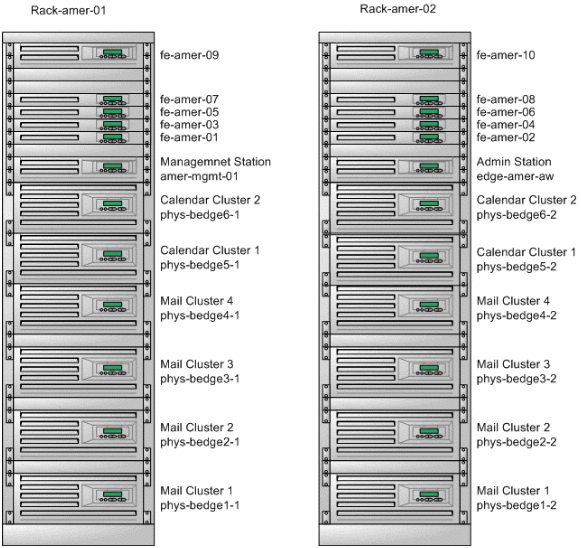1.1 Access Anywhere Architecture
The architecture of an EdgeMail complex is composed of its hardware and software designs.
1.1.1 Hardware Components
The general hardware design of the EdgeMail complex includes the following components:
-
Front-end (FE) servers that receive client requests through a firewall. There are 10 front-end Sun Fire V210 servers.
-
Back-end (BE) servers organized in clustered pairs. There are 4 mail clusters and 2 calendar clusters, for a total of 12 back-end Sun Fire V440 servers.
-
A hardware and operating system management station on a separate Sun Fire V240 server.
-
A software administration station on another separate Sun Fire V240 server.
-
Two redundant storage area networks with three McData Sphereon 4500 fibre channel switches each, for a total of 6 dedicated switches.
-
Six sets of disk arrays, each containing 3 Sun StorEdge 3510 arrays, coupled with 8 Sun StorEdge 3511 arrays, for a total of 26 disk arrays.
-
A large backup server consisting of a Sun Fire V880.
In addition, the EdgeMail complex should include hardware such as the Sun StorEdge L180 or L700 tape libraries for the backup of all data on disk. However, tape libraries are not included in this deployment example.
1.1.2 Racking Diagrams
The following racking diagrams give a physical dimension to the size of an EdgeMail complex. All hardware in the complex occupies 5 full-height hardware racks. Such racks are intended to be deployed in a data center where all the power, cooling, and network connectivity needs are provided.
Figure 1–1 Hardware Racks 01 and 02

Figure 1–2 Hardware Racks 03 and 04

Figure 1–3 Hardware Rack 05

1.1.3 Software Design
The software design of the EdgeMail system is best described as a multi-tier architecture shown in the following diagram.
Figure 1–4 Multi-Tier Software Design for Access Anywhere

1.1.3.1 User Tier
The users of the EdgeMail system are corporate employees who may be located on the internet or on the corporate intranet. The EdgeMail complex is located behind a firewall to protect both front-end and back-end servers.
From the internet, employees may use any web browser to establish a secure connection to their corporate email and calendar accounts. Security is performed over HTTPS with SSL and certificates to verify user identity without requiring the overhead of VPN (virtual private network).
From inside the corporate network, employees may also use any web browser to view their email and calendar accounts through their familiar portal. Users may also choose to access their accounts through any IMAP email client such as Mozilla. In either case SSL is not used, further reducing overhead.
1.1.3.2 Front-End Tier 1
The front–end tier is in charge of receiving user connections from web browsers and presenting services to the user. The front-end hardware hosts the components that make up tier 1.
The Sun Java System Communications Express and Sun Java System Portal Server components provide the web interface to each employee's email and calendar accounts. Both of these components rely on the Sun Java System Web Server component to provide the web infrastructure to respond to client requests.
1.1.3.3 Back–End Tier 2
The back-end tier is where client requests are processed and business services are performed. The back-end hardware hosts software components that make up tier 2. Here, the Sun Java System Messaging Server component handles all user operations for accessing mailboxes and handling inbound and outbound mail. The Sun Java System Calendar Server handles all interaction between users and their calendars, including email notifications through Messaging Server.
The business services on the back-end hardware also includes the security and identity verification provided by Sun Java System Access Manager and Sun Java System Directory Server.
1.1.3.4 High Availability
In addition to the software components in two tiers, the Access Anywhere design includes Sun Cluster software to provide high availability in case of hardware failure. Each cluster consists of two redundant nodes that run the same software components. Back-end clusters connect to the storage area network (SAN) which includes both redundant switches and redundant disks for fail-safe operation. For more information about the SAN architecture, see 2.2 Storage Area Network (SAN).
The EdgeMail example deploys 4 clusters running Messaging Server and 2 clusters running Calendar Server. System scalability is achieved by increasing the number of clusters according to user needs, which simply involves adding pairs of back-end hosts.
- © 2010, Oracle Corporation and/or its affiliates
